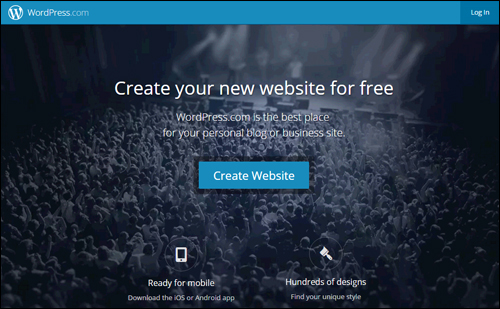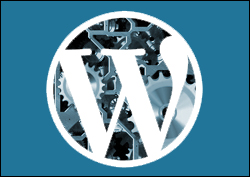
Welcome to Part 3 of our WordPress Website Traffic Blueprint article series, where we show you how to drive visitors automatically to your website using WordPress.
In Part One of this series, we provided an overview of the process, and explained why using an expertly configured WordPress website is the key to automating traffic to your website …
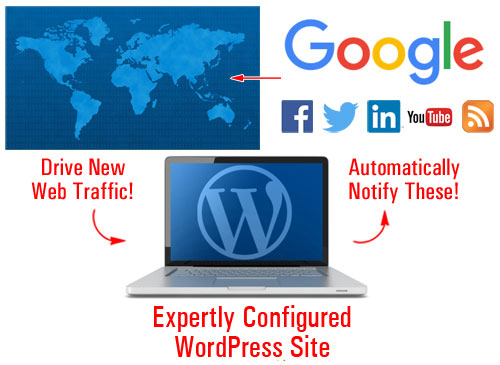
(With an expertly configured WordPress web site, all you have to do to bring traffic is post web content on a regular basis!)
In Part 2, we focused on the setup phase of the traffic automation process. We helped you understand the best way to start if you don’t have a website yet, how to set things up if you already have a site, and what to do if your existing site has been built using WordPress.
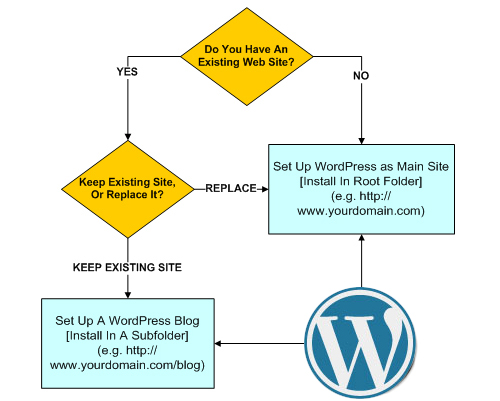
(In Part two we show you where to set up WordPress on your domain)
In this section of the series, we will look at the configuration stage of the WordPress traffic automation system. We explain how a WordPress site should be configured in order to get web traffic automatically as you begin publishing new content on your site.
WordPress Traffic Blueprint – Configuration Phase
The ability to drive more traffic to one’s website is often cited by many business owners as the greatest challenge they face online. Businesses are becoming ever more competitive and are researching every advantage they believe will increase their competitiveness online.
Having the ability to generate traffic on demand is a tremendous advantage over other competitors. Having an expertly configured WordPress site gives you a significant competitive advantage from the word “go”.
Configuration Is The Difference
There is a difference between an expertly configured WordPress site and a website that has been professionally installed and set up by an expert website developer but not necessarily configured to its fullest advantage.
Here is a simple way to explain the differences:
With a WordPress website that has been expertly configured you get a web presence plus an automated online business marketing tool!
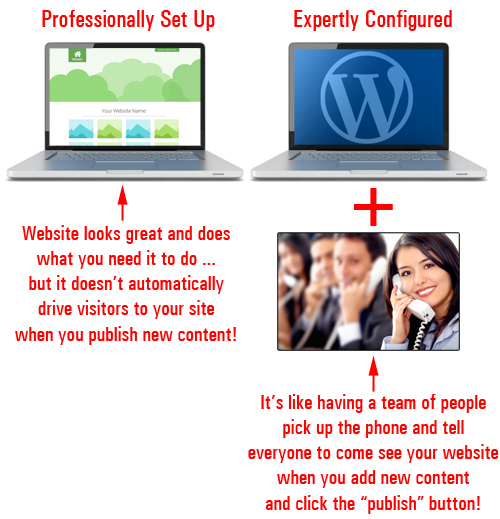
(An expertly configured site gives you a professional web presence with an automated online business marketing tool!)
Not only does it take additional labor to build and integrate an automated online business marketing system into your website, it also takes a special kind of expertise.
Let’s illustrate this with a joke.
Ludicrous Or Fair? You Decide …
Things were moving along in the widget plant when all of a sudden, everything ceased working.
As no one could figure out what happened, the manager decided to call in an expert.
Shortly after arriving, the expert walked directly to the control box. After staring at the wires and circuitry for less than 3 minutes or so, the expert then produced a tiny hammer from his shirt pocket and made a gentle tap about 2 cm from the left corner of the box.
Immediately, everything started working again.
The plant manager was grateful and relieved as he thanked the expert, who left as quickly as he had arrived.
A few days after resolving the incident, the manager received a bill for $5,000.
The factory manager dialled the expert, demanding to know why they had been charged so much for less than 5 minutes work. He then requested an itemized invoice before hanging up.
The next day, an invoice arrived and was placed in the manager’s in-tray. Upon opening it, this is what he saw:
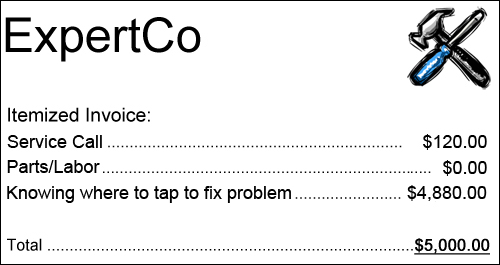
The number one challenge most businesses face online is driving new visitors to their sites.
In the above story, how much money did the plant stand to lose when production stopped working and no one on the factory floor had the expertise to get things up and running again? Did the expert in our story not have the right to demand fair compensation for having invested years acquiring the knowledge, skills and expertise that enabled him to avert a very serious crisis?
Similarly, if you could have your WordPress site fully set up and configured so all you ever had to do is publish content to it and Google, Facebook, Twitter, LinkedIn, YouTube and dozens of other web properties would be instantly notified, how much time and money would you save?
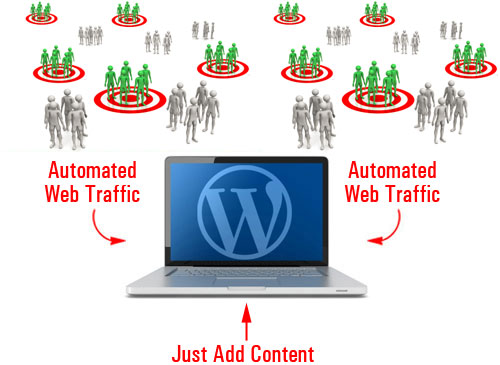
(How much time and money would you save if you could automate the process of attracting new visitors to your site?)
Although experts often make difficult solutions look easy, it rarely turns out to be that way.
Expertly configuring a WordPress site involves more than installing a website and configuring a few settings. It requires knowing where to tap! In other words, knowing things such as:
- Which plugins need to be installed to add various functionalities to your site.
- Which accounts need to be set up and activated to achieve desired outcomes
- Which internal and external settings need to be configured to make sure things work exactly as you want, etc.
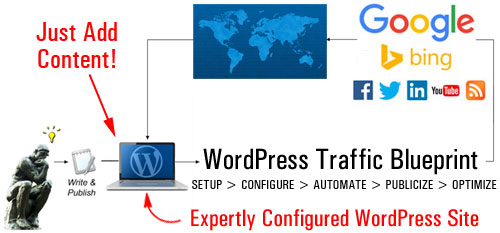
(Driving web traffic automatically with WordPress is a process that requires expertise)
This stage of the traffic automation system is not technically difficult, but it’s quite involved. It’s not just about installing and configuring a piece of software, configuring some settings in your admin area … it’s all this and so much more.
Expertly configuring your website is a process that involves your web server, your website or blog, and a number of external sites or online services …
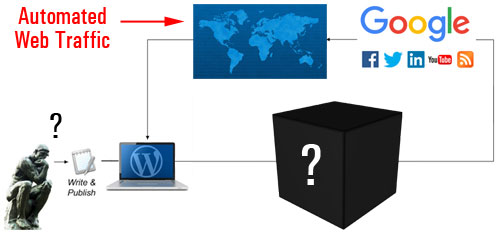
(Expertly configuring your website involves more than just configuring some settings in WordPress)
If we try to flowchart the activities involved in the configuration process, it would look like this …
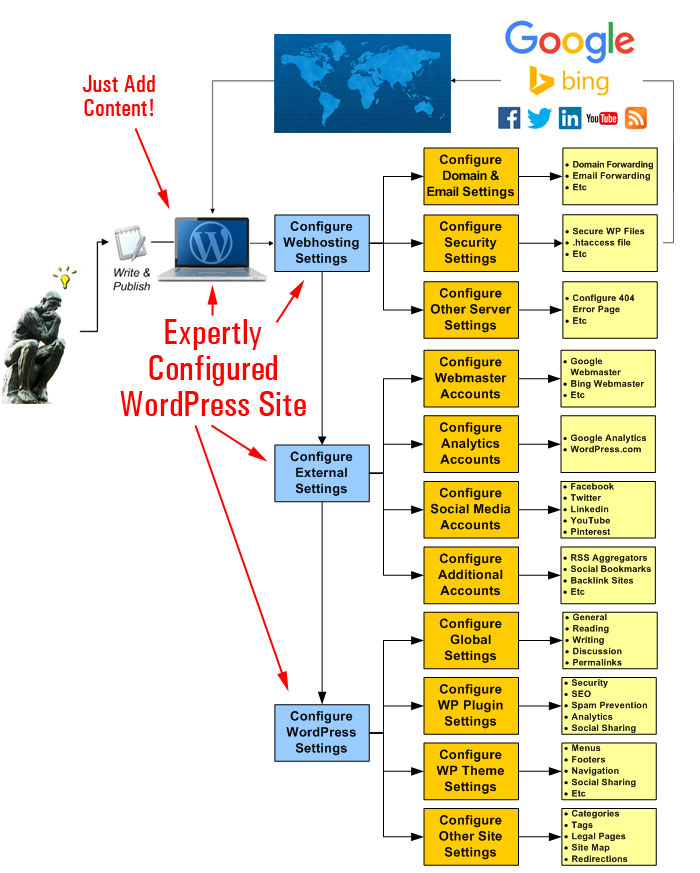
(A simplified diagram of all the steps involved in the configuration phase)
Let’s take a look at these steps in more detail.
Your Web Server
We’re not talking about the process of configuring your webhosting account for installation purposes. We’re talking about configuring settings and options in your server that affect how your site will handle all web traffic …
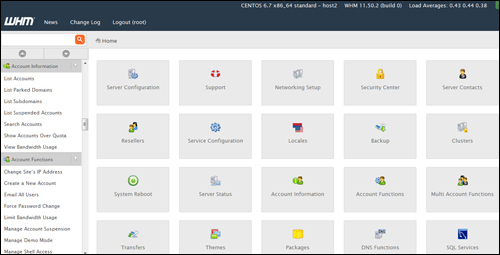
(In the configuration stage, your server settings need to be fine-tuned for handling both good and bad traffic)
Not all traffic is positive traffic. Some of the web traffic your site will attract will be unwelcome traffic like bot spam, malicious threats, brute-force bot attacks, etc.
This stage of the configuration process, therefore, requires evaluating your needs, planning for both bad and good traffic and adjusting settings in your server accordingly. This can include looking at things like server-level spam protection and securing server files, to configuring domain and email redirections, etc …
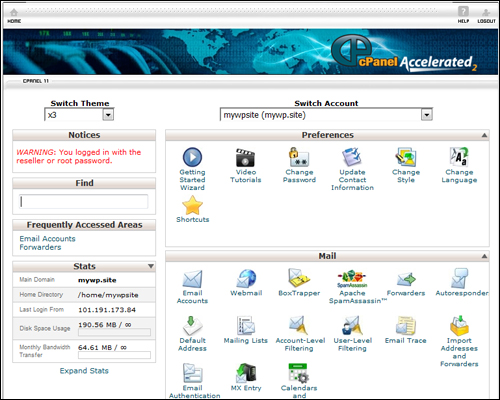
(Have you configured your webhosting settings for handling things like emails, page error redirects, etc?)
After your web server settings have been checked and configured (if required), the next step is to configure various external sites and online solutions.
External Services
The basic idea of choosing external sites is that all content should be posted to a central location (your site) and from there, be distributed automatically to other components of your traffic system, or notify traffic-related web properties and services.
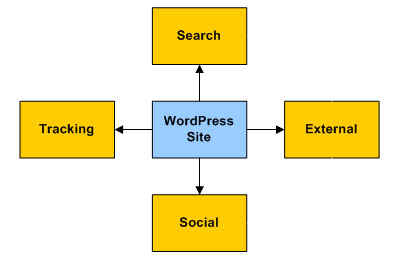
Once you incorporate these external services into your traffic network, content linking back to your site gets automatically fed to these platforms, indexed by search engines and shared to other social media sites, even to visitors attracted to the platform itself. Your content and site will be given additional exposure to new sources of traffic and new audiences.
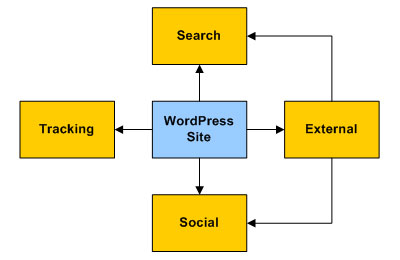
Some of these web properties and online platforms will need to be set up before configuring your WordPress settings to help speed up the process and some will need to be done later, during the automation phase.
For example, here are just some of the accounts you will need to have set up:
Google Search Console
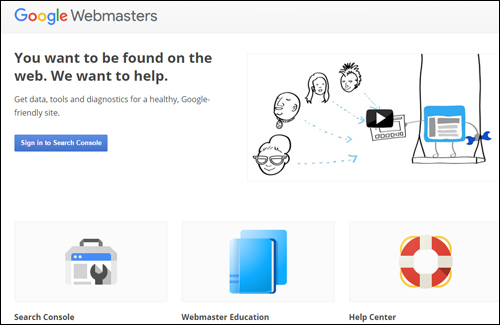
(Google Webmaster Tools – create a Google-friendly website or blog)
Google Webmasters lets you notify Google about your site’s pages, submit XML sitemaps for automatic page indexing, and provides site owners with essential information, tools, and reports about their website.
Once your Google Webmaster Tools account is set up, use your information with web traffic-related settings and notifications in WordPress and other applications.
Google Analytics
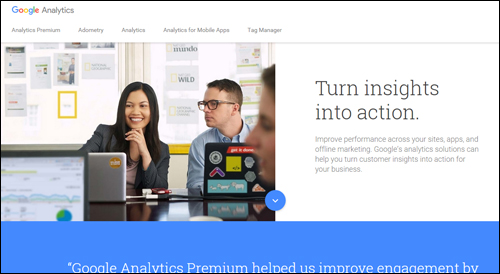
(Google Analytics)
Google Analytics lets you improve your website’s performance, SEO, marketing activities, and more, by tracking all user behaviour, pages visited, keywords searched for, organic referrers, etc.
After setting up your account, account data can be easily integrated with WordPress via a simple Google Analytics plugin and automatically sent to many other useful applications and reporting tools.
Bing Webmaster Tools
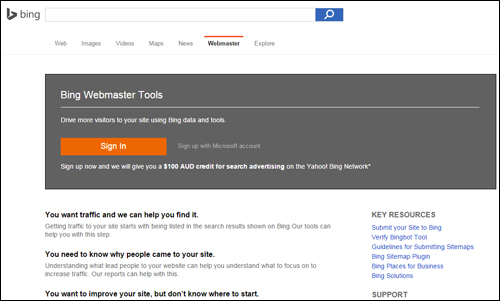
(Drive more traffic with Bing Webmaster Tools)
Bing Webmaster Tools is similar to Google Webmaster Tools. After setting up your account with Bing, the account details can be used with web traffic settings and notifications in WordPress using plugins like Yoast SEO (see further below) and other applications.
WordPress.com
(WordPress.com)
As explained in Part Two, WordPress offers both a hosted and a self-hosted option. We recommended choosing the self-hosted WordPress platform if you plan to build a professional online presence for your business.
WordPress.com (the hosted option), however, provides a number of useful features, which various WordPress plugins can access. We recommend setting up an account with WordPress.com, therefore, and we’ll explain how to integrate these features into your traffic generation system in the next installment of this article series.
Social Media Pages

(Syndicate your content automatically to your social media and social bookmarking accounts and bring new traffic to your site)
You will need to set up your social media accounts in order to integrate these with your traffic generation system.
Once you have set up and configured everything, you will be able to syndicate your content automatically to your social media pages and bring new visitors to your site.
Make sure you have accounts and profiles set up with all of the well-known social networks – Facebook, Twitter, YouTube, Pinterest, LinkedIn, etc.

There are many social sites you can You can syndicate your content to lots of social bookmarking sites. You don’t need to go crazy, just choose the ones that will work well with your system and/or content syndication tools.
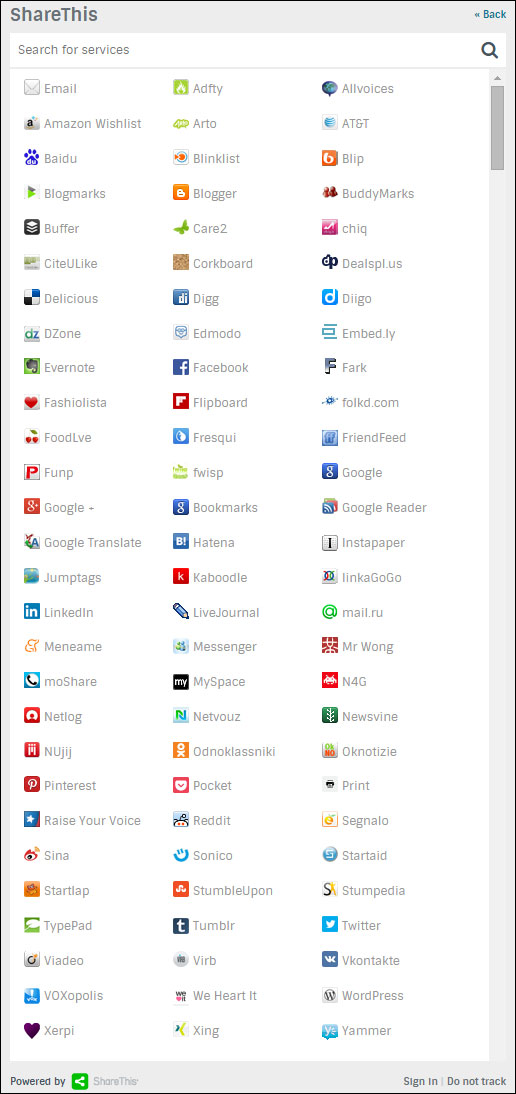
(There are loads of social bookmarking sites you can post your content to. Image source ShareThis.com)
Additional Services, Content Aggregators, Etc.
There are a number of online platforms and RSS aggregators that can serve as second-tier sources of traffic. Some are free or provide free accounts, and some offer a range of pricing plans.
For example, here is a content aggregator that allows you to add your WordPress site feed …
RebelMouse
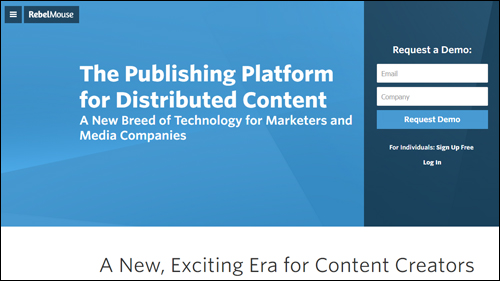
(RebelMouse – Publishing platform for distributed content)
RebelMouse is an aggregator for your social profiles and RSS feeds. Your content displays in a Pinterest-like format and visitors can follow your RebelMouse page.
![]()
There are various platforms you can incorporate into your own web traffic system. Please feel free to contact us if you need assistance exploring this area further, or to discuss a configuration plan to suit your needs.
After you have configured your web server and set up third-party site accounts, it’s time to configure your WordPress site’s settings.
WordPress Configuration
The first step in configuring your WordPress site for traffic is to make sure that your global settings have been correctly set up.
Let’s go over some of the important areas.
Configuring WordPress Settings
Your WordPress administration area contains a Settings section that allows you to configure your site’s global settings …
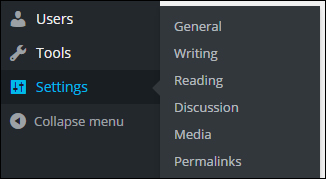
(WordPress settings menu)
General Settings
Content entered into fields like Site Title and Tagline can affect traffic by influencing your site’s SEO, search indexing, etc …
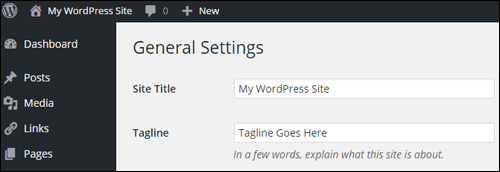
(Global Settings – General Settings Section)
Writing Settings
The Writing Settings area contains a powerful and often overlooked built-in traffic notification system …
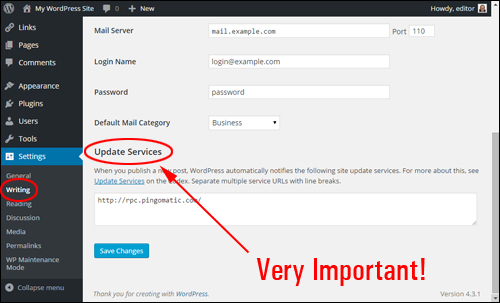
(Global Settings – Writing Settings)
As described in this section,
When you publish a new post, WordPress automatically notifies the following site update services …
Unless you or your webmaster have purposely configured your site settings to discourage search engines from indexing your site, then your site will automatically notify the services entered into the Update Services field
With an ‘out of the box’ WordPress installation, this section includes only one entry …
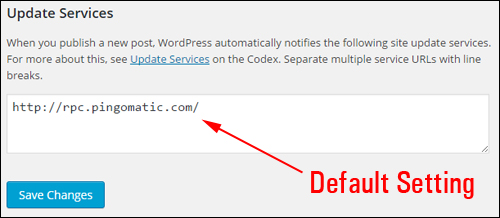
(Update Services – A Powerful Traffic Feature Of WordPress)
WordPress lets you notify dozens of update services automatically …
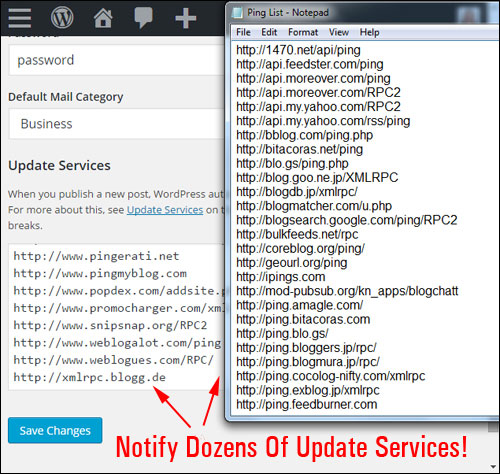
(Notify dozens of update services automatically with WordPress!)
![]()
Download A Comprehensive List Of Ping Services For Your WordPress Site!
Click the link below to download a comprehensive list of reliable and authoritative ping services for your WordPress site or blog:
Download A List Of Ping Services For Your WordPress Site
***
Note: If you need help setting up the list of ping services on your site, we recommend using a professional web services provider. You can find professional WordPress service providers in our WordPress Services Directory.
Reading Settings
This section affects how visitors will see your content when they visit your home page and blog pages.
The syndication settings on this page can have an influence traffic. For example, your choice to display the full text vs a summary of your post, affects how your content displays to users in RSS feeds and blog post digests, and could affect someone’s decision to explore your site further, and whether or not they will visit your blog to read the rest of the content from excerpts, or read the content in full without the need to click through to your site.
The most important setting here as far as traffic is concerned is whether the Search Engine Visibility check box is enabled or not.
Typically, you want search engines to visit your site. Leaving the box unchecked enables WordPress to automatically ping various update services whenever new posts are published (see Writing Settings above). Unless you have a specific reason to discourage search engines from visiting your site, leave this box unchecked …
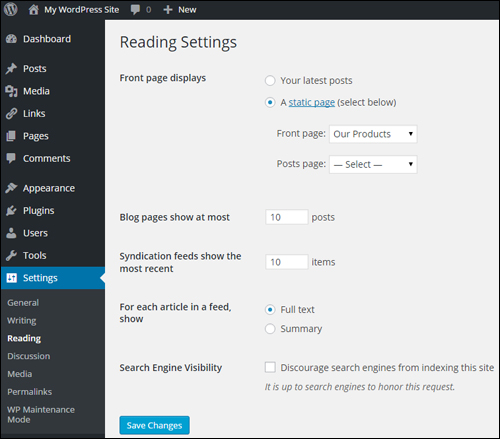
(Global Settings – Reading Settings)
Discussion
Although discussion settings are mostly concerned with how users engage with content on your site, you have the option to allow notifications to blogs linked to from your posts, and to allow link notifications from other blogs (pingbacks and trackbacks). This can work for you, but it can also drive bad traffic in the form of SPAM comments …
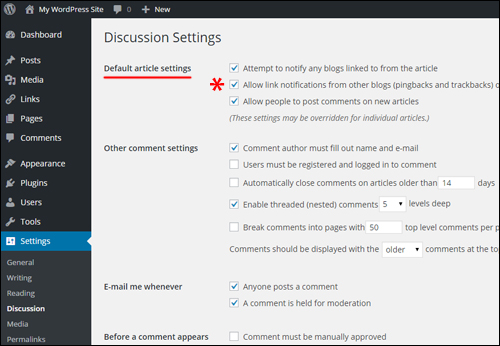
(WordPress Settings – Discussion Settings)
Permalinks
Your Permalink settings allow you to create search engine-friendly URLs …
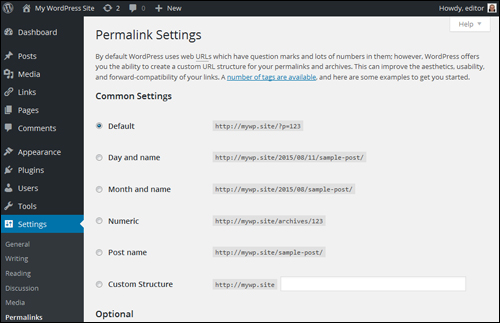
(Global Settings – Permalinks Screen)
Here are some of the options for configuring your site’s permalinks …
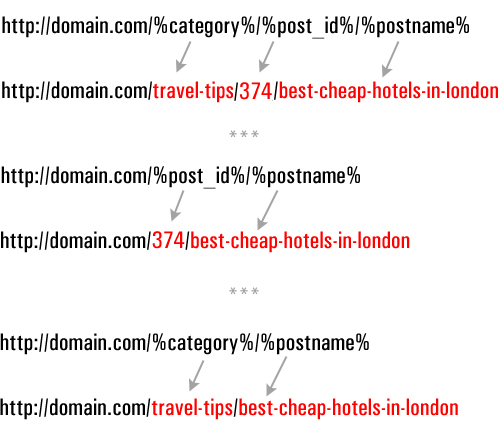
(Configuring permalink URLs)
We have created a detailed tutorial on using permalinks in WordPress here: Configuring WordPress Permalinks
Configuring Settings – WP Plugins
WordPress provides users with thousands of plugins that can add just about every kind of functionality imaginable to your site, including plugins with features that help to improve traffic generation.
Here are some types of plugin categories that affect traffic and plugin examples
Blog Defender WordPress Security Plugin
Once again, it’s important to configure your website for dealing with both good traffic and bad traffic. Regardless of the type of business you run or plan to run online and how small you think your web presence is, you simply cannot ignore the importance of web security.
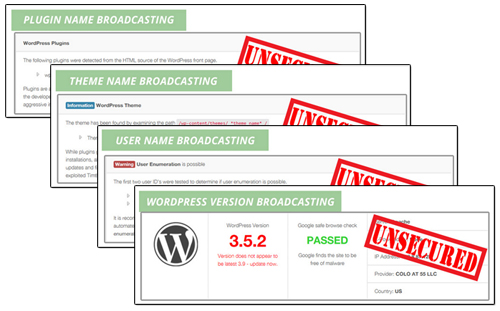 (Security Plugins help prevent bad traffic from causing your website harm)
(Security Plugins help prevent bad traffic from causing your website harm)
Security plugins like Blog Defender help to make your blog invisible to botnets and hackers.
More info:
WordPress SEO Plugins – Yoast SEO
WordPress SEO plugins help drive more traffic by making your website more search engine friendly …

(WordPress Plugin – Yoast SEO)
A plugin like Yoast SEO can improve your SEO. Properly configured, this plugin not only makes your web pages easier for search engines like Google to find and index, it also lets you specify how your content will show up in Google’s search results and social media sites Twitter, Facebook, and GooglePlus.
WordPress Social Sharing Plugins
Allowing your visitors to easily share your content with their social networks can help boost traffic to your site, especially if you provide great content that adds value to readers.

(WordPress users can easily add social sharing features to their website with free or inexpensive plugins)
There are loads of social sharing plugins available for WordPress.
Most social sharing plugins let you specify which sites visitors can share your content to, embed social buttons into your content, set up custom update notifications, display/hide share counters (e.g. number of likes), etc. Some social share plugins even allow you to set up protected content sections on your site which users can unlock by linking or tweeting your page.
Theme Settings
As well as configuring various plugins, many WordPress themes also include features that help you drive more traffic to your site.
For example, in addition to options and settings for configuring layout and design elements of your site, many themes also give you built-in options for improving search optimization and site linking structure for faster indexing, easily add tracking code, social sharing buttons, etc …
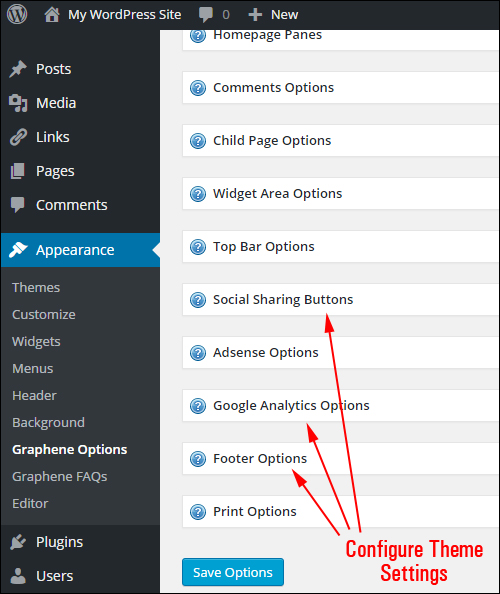
(Many themes have built-in traffic optimization features)
With many WordPress themes, adding social sharing buttons and features to your website is as easy as selecting the option to enable this functions …

(Many WordPress themes provide built-in social sharing features that can be easily turned on with the click of a button)
Additional Configuration Areas For Your WordPress Site
Last but not least in the web traffic configuration process, are the elements that need to be set up outside of the global settings.
These include:
Website Legal Pages
Once again, when preparing your site for a growth in traffic numbers, it’s important to plan not only for both good and unwanted traffic but also for all the situations that can damage your business as more and more people start finding and visiting your website.
If you engage in any form of business online (or are planning to), it’s important that your website remains compliant with regulatory agencies.
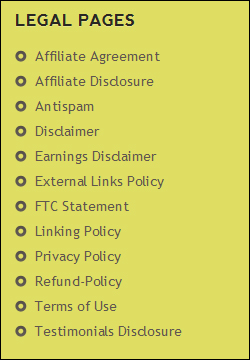 (Does Your Website Or Blog Comply With All Legal Requirements?)
(Does Your Website Or Blog Comply With All Legal Requirements?)
For a detailed article about the importance of having a legally compliant website, go here:
WordPress Categories & Tags
WordPress categories & tags help improve traffic by improving your site’s SEO.
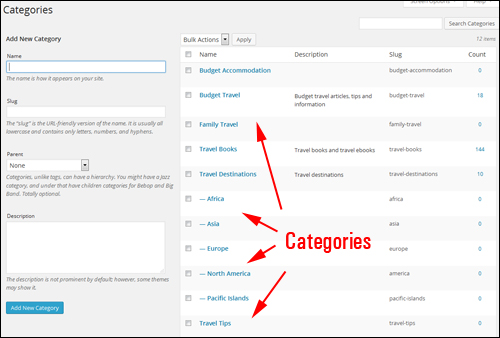
(WordPress categories help improve traffic by improving your site’s search optimization.)
As we strongly recommend in this article, it’s best to set up your site’s tags and categories earlier on, during the Website Planning Stage.
When looking at ways to automate and improve traffic, you will want to review and make sure that the post tags and categories you have set up.
Add A Site Map To Your WordPress Site
A site map that lists all of your site’s posts and pages to visitors is not only a useful navigation tool, it can also help external tools discover your website content …
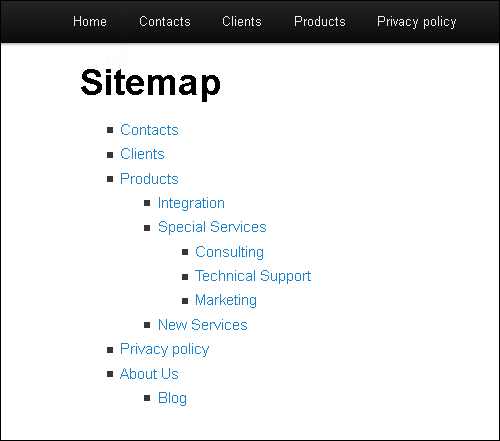
(Site Map – great for site visitors and beneficial for web traffic too!)
![]()
Note: An HTML site map and an XML sitemap are two different things. HTML site maps are web pages that provide readers with a logical map of how your content is structured, whereas XML sitemaps are mostly just a bunch of code that only search bots can interpret. Although search engines like Google can index your pages just using an XML sitemap (which a plugin like Yoast SEO can provide – see earlier section), allowing visitors to find more pages on your site can result in increased traffic.
Configure Your 404 Page Not Found
When visitors searching for your website enter the wrong URL or click on hyperlinks pointing to an incorrect destination on your website, they are presented with an error page (known as a 404 page) …
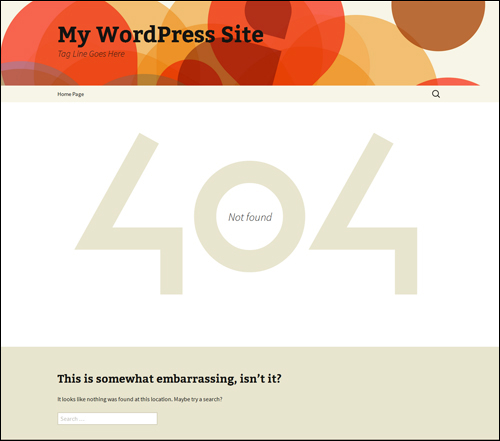
(A WordPress 404 Error Page)
Configuring your 404 page allows you to recover web traffic that may otherwise be lost. …
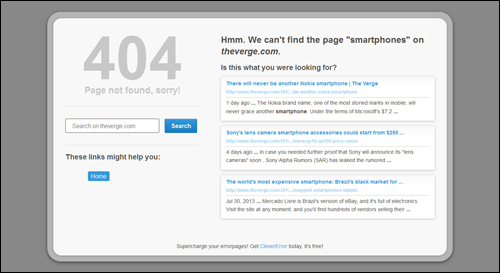
(Configuring your 404 Not Found page allows you to recover web traffic that may otherwise be lost.)
![]()
Although a 404 error page can be set up on your server, there are several WordPress plugins that let you easily configure your 404 page inside your WordPress admin area.
WordPress Traffic Automation System: Configuration Process – Summary
Once your site has been fully set up and expertly configured, all you need to do to automatically start attracting traffic is post new content on a consistent basis.
The process of expertly configuring a WordPress site, however, is quite involved , requiring the configuration and integration of different elements and external web properties …
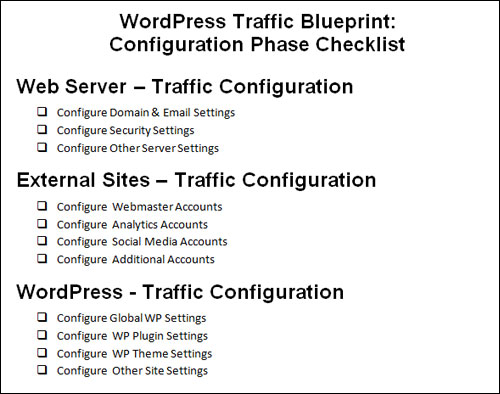
(WP Traffic Blueprint – Configuration Phase Checklist)
![]()
The kind of expertise involved in expertly configuring a WordPress site typically takes many web developers a long time to acquire.
Once you have configured your WordPress site, the next step is to automate as much of the process as you can. This step is explained in the next section of our WordPress Traffic Blueprint series.
This is the end of Part 3
To read more, click on the link below:

![]()
This article is part of a comprehensive tutorial series designed to help you learn how to grow your business online inexpensively with a WordPress-driven website and proven online marketing methods.
Get Notified When New Tutorials Are Published – Subscribe To Our Site!
***
"If you're new to WordPress, this can stand on its own as a training course and will stay with you as you progress from beginner to advanced and even guru status." - Bruce (Columbus, Ohio)
***

